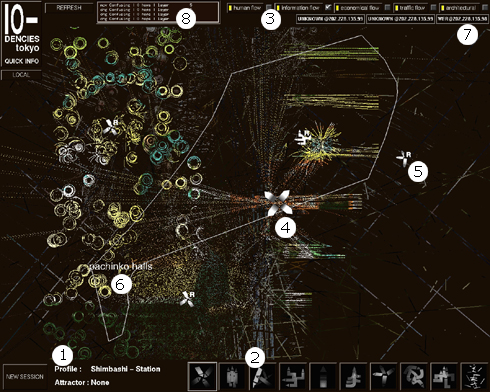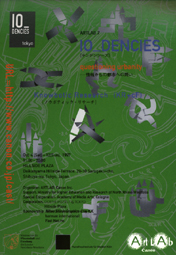
IO_DENCIES consists of a distributed electronic topology which will be opened for the public. Participants can develop collaboratively urban dynamics: Participants can download an urban profile of the selected local area of Tokyo. An urban profile consists of a set of urban dynamics (human, information, economic, traffic, architecture, 'histories') read out by a local architect (Sota Ichikawa). As soon one participant starts working and modifying on the urban profile by changing the particle streams with movement attractors, a search engine in the background starts looking and connecting in the IPspace for other participants with similar manipulation interests. If another participant is found, the characters of the data movements are changed collectively in tendencies , are made stronger, weaker, wilder, thinner, more turbulent, open, dense...... . That means streams of urban movements can shift between dynamic clusters of participants, chains of events are passing through. Participants can develop new processes or react to already existing running ones. The streams of the manipulated movements are visualized and made audible in the activated segment of a participant - but each participants will work on and experience a singular and different segment.
krcf
An user can observe movements and functions of the flows shown on the screen, and freely change (strength or weaken) them by dragging attractors of ten different functions in manipulating or modifying the urban flows. The attractors work on the existing flows. An user can choose functions, determine the spere of influence, and set the level of parameter (+ or -).
In the selected urban zones several qualities of urban movements (architectural, traffic, human, information, economic) were distinguished. These movements and flows and their mutual interferences are represented by dynamic particle flows which can be downloaded as an urban profile (each participant is only working on one profile of the 10 different areas) observed and manipulated through an Internet interface: in a Java-applet users can deploy a series of specially designed movement attractors, each of which has a different function in manipulating or modifying those processes. These are functions like: confirming, opposing, drifting, confusing, repulsing, organizing, deleting, merging, weakening etc. Participants can collaboratively develop hypothetical urban dynamics. As soon as one participant starts working on and modifying the urban profile by changing the particle streams with movement attractors, a search engine in the background starts looking in the IP-space for other participants with similar manipulation interests and connects to them. They become present for each other, the IP-address and the activated movement attractors of connected participants will appear in the applet. Some of these can be 'absent' users whose activities are remembered and reactivated by the system for some time after the intervention took place. If another participant or more are found, the characters of the data movements can be changed collaboratively in tendencies, they can be made stronger, weaker, more turbulent, denser, etc. Streams of urban movements can shift between dynamic clusters of participants, chains of events are passing through. Participants can develop new processes or react to already existing, ongoing ones. The streams of the manipulated movements are visualized in the activated segment of each participant, however, each participant will work on and experience a singular and different segment.
Interface
1997

UP= Homeless Zone
1 = information about the selected urban profile
2 = attractors to intervene with the given flows of the UP
3 = the different flow layers, which can be choosen: human, information, economical. traffic, architectural
4 = the dragged attractor
5 = an remote attractor (shows the action of an other participant)
6 = the textual information inside the visualization gives information about so called "singularities", specific events inside the urban field
7 = the nickname and IP adress of the remote participants
8 = Log_File
